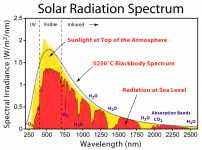http://csep10.phys.utk.edu/astr162/lect/sun/spectrum.html
Check out the spectrum in this graph.
View attachment 185110
Note, that it is a nice smooth wave.
Also, because it is so far away, for lack of a better term, the light is homogenous. (well mixed and smoothed)
http://upload.wikimedia.org/wikipedia/commons/4/4c/Solar_Spectrum.png
smooth isn´t it on Earth






